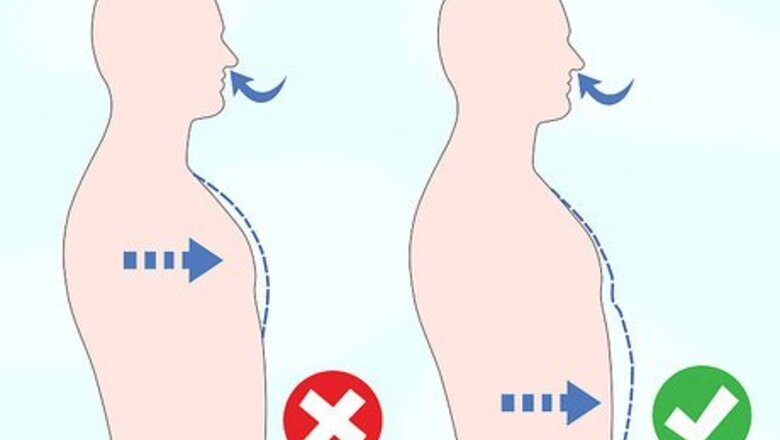
views
Take deep breaths and avoid shallow chest breathing.
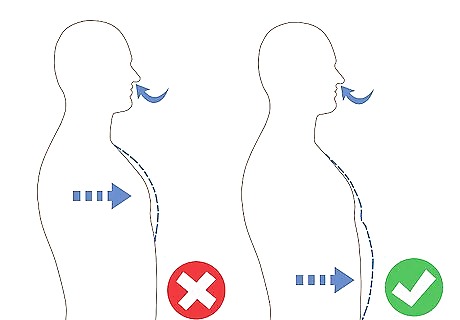
It’s easy to get in the habit of taking short, shallow breaths. It’s important to train yourself to breathe deeply since deep breaths are better at oxygenating your body and can actually help reduce stress. Take a moment to pay attention to your breathing. If only your chest is rising and falling when you breathe, you’re likely taking shallow breaths. Try practicing deep breathing for several minutes every day. Over time, it will become easier and feel more natural.
Remember to breathe with your diaphragm.
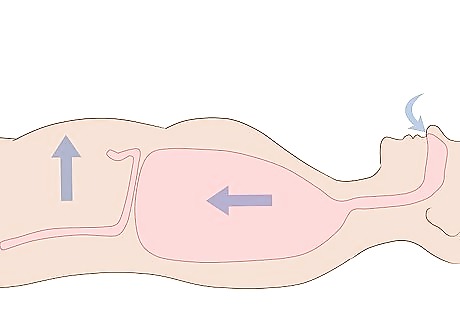
Your diaphragm is a thin muscle underneath your lungs. When you take a deep breath, your diaphragm moves downward and gives your lungs more room to fill up and expand. To breathe from your diaphragm, inhale deeply through your nose like you’re breathing into your lower belly. You should feel your abdomen expand when you inhale. If you’re not sure whether you’re breathing from your diaphragm, try placing your hand over your belly. Then, inhale deeply through your nose, and see if your hand is pushed up by your stomach. If it is, you’re breathing from your diaphragm. Breathing from your diaphragm can actually slow your heartbeat and lower or stabilize your blood pressure.
Inhale through your nose instead of your mouth.
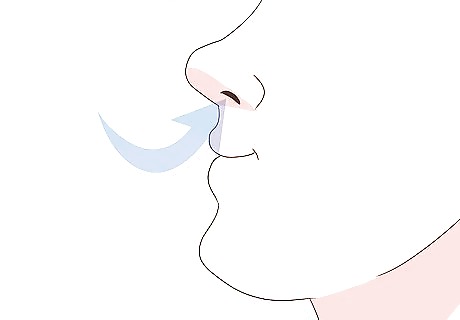
Breathing through your nose helps purify the air. This helps you avoid inhaling as many irritants. It also regulates the temperature of the air you’re breathing in. If you normally breathe through your mouth, practice closing your mouth and inhaling through your nose. Then, exhale through your nose or mouth, whichever is most comfortable. Inhaling through your nose might be difficult at first if you’re used to breathing with your mouth, but it will get easier over time with practice.
Maintain good posture and keep your body relaxed.
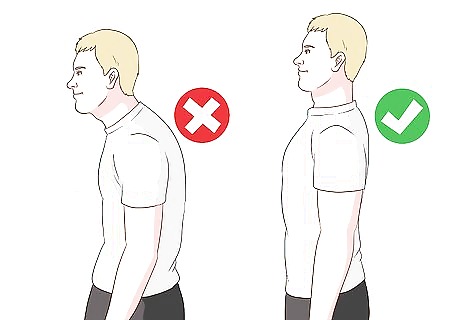
Slouching makes it harder to take full, deep breaths. Instead, you want to stand up straight, relax your shoulders, and loosen your joints so it’s easier to breathe. Try slouching forward, lifting your shoulders toward your head so they’re tense, and taking a deep breath. Then, stand up straight, relax your shoulders, and take another deep breath. You should be able to feel how much easier it is to breathe when you have a good posture. Whenever you catch yourself slouching or tensing up, adjust your posture and take a moment to relax your muscles.
Check in on your breathing throughout the day.
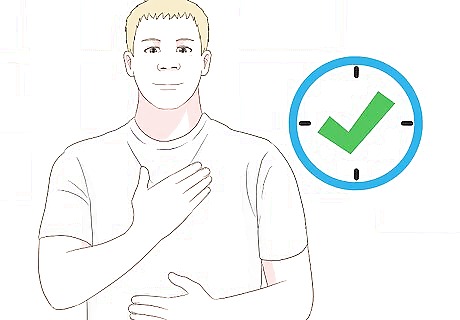
Schedule regular check-ins to stay focused on your breathing. Since you don’t usually realize that you’re breathing, it can be tricky to notice whether or not you’re doing it properly. Try to check-in at the same time every day, like each morning and lunchtime, so that it becomes part of your routine. Being more mindful of your breathing can help you make adjustments if necessary. For example, if you notice that you’re taking shallow breaths whenever you check on your breathing, you’ll know to work on taking deeper breaths from your diaphragm.
Try calming breathing exercises when you feel stressed.
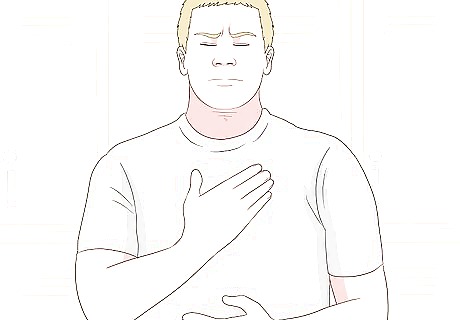
Deep, purposeful breaths calm you down in stressful or scary situations. To make deep breathing easier, try practicing a couple of breathing exercises so you can use them the next time you're feeling overwhelmed. For example, you can quickly relax when you're feeling stressed by taking deep breaths through your nose and then sighing out loud on your exhales. If you ever feel like you're on the verge of having a panic attack, take a deep breath in for 3 seconds, hold it for 3 seconds, and then slowly exhale through pursed lips. Repeat the exercise until you calm down. To stop hyperventilating, try inhaling slowly through your nose for 7 seconds and then exhaling for a count of 11.
Practice deep breathing exercises.
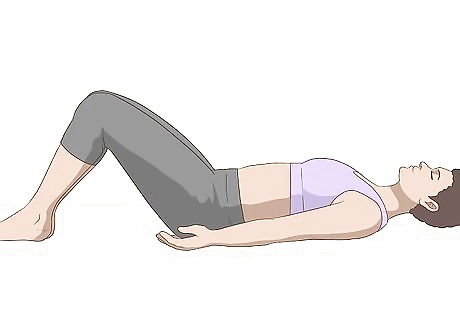
Get into a comfortable position. You might find it easier to take deep, slow breaths if you are lying down or sitting in a comfortable chair. Try lying on your back on a blanket, sofa, or bed with your arms lying loosely at your sides. Next, breathe in through your nose, letting your chest and lower belly rise as you fill your lungs with air. Relax and let your abdomen fully expand. Breathe out through your mouth. Repeat for 10-20 minutes every day. Deep breathing exercises help you take the time out of your day to focus on just your breaths. This can help you relax in the moment and improve your form when breathing throughout the day. You can also use pillows to support your head and knees if it helps you feel more comfortable.
Try meditative breathing.
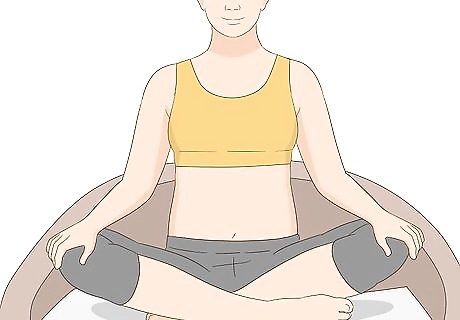
Find somewhere comfortable to sit with your back straight. Sitting up straight will open up your lungs and make it easier to take deep, steady breaths. Next, take a few deep breaths. The goal of meditative breathing is to slow your breaths, help your body take in more oxygen, and be mindful of how you’re breathing. As you do so, let go of your thoughts and any distractions around you. Instead, focus on only your breath as you inhale and exhale. If you struggle to relax at first, start by meditating for five minutes. As you get more comfortable, move that up to 15-20 minutes. Even just a few minutes of meditation provides benefits! Meditative breathing can train you to become more mindful and present. Try sitting in a comfortable chair or on a blanket on the floor with your legs crossed. If your mind wanders and you notice yourself thinking about something else, just return your focus to your breathing, and continue to slowly inhale and exhale.
Take deep belly breaths when you run.
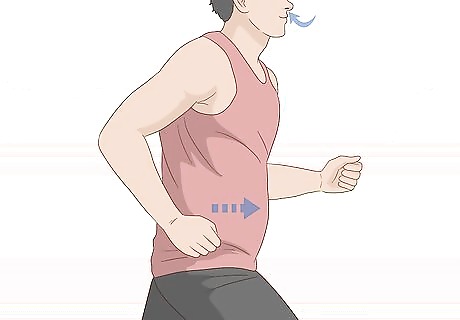
Breathing deeply while you run fills your lungs with more oxygen. This gives your body more energy to keep running. If you’re only taking shallow chest breaths when you run, try to practice breathing from your diaphragm so your belly expands when you inhale. If taking steady, deep breaths is hard for you to do while you're running, try experimenting with different breathing rhythms until you find one that's comfortable. For example, you could inhale deeply once and then exhale out of your mouth twice.
Inhale and exhale on a 4 count during core exercises.
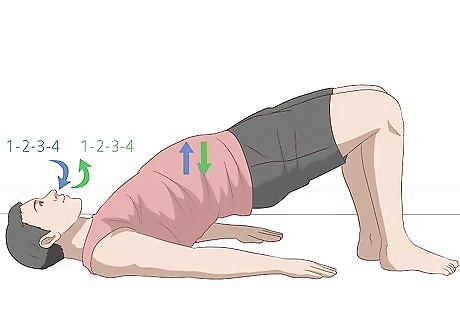
Avoid holding your breath during core and abdominal exercises. Doing so can make your workout harder for your muscles. Instead, as you do your exercises, maintain a steady 4 count as you inhale, and then another 4 count as you exhale. That way, you’ll breathe consistently as you work out your core.
Breathe in through your nose during high-intensity exercises.
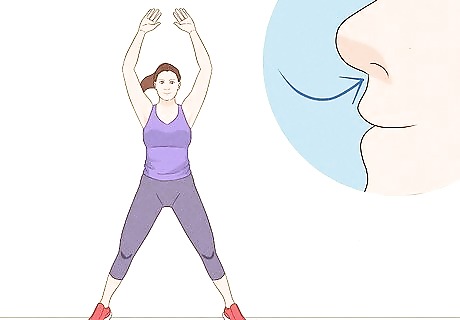
High-intensity exercises like jumping jacks require a lot of oxygen. Taking in a lot of air through your mouth can actually reduce your body’s ability to use oxygen as energy. Instead, inhale through your nose during these exercises so you’re getting more oxygen into your body. This will help you work out for longer, too! If you're having trouble breathing through your nose, try reducing the intensity or duration of your exercises until you're able to do them without inhaling through your mouth.
Breathe rhythmically as you do strength-training exercises.
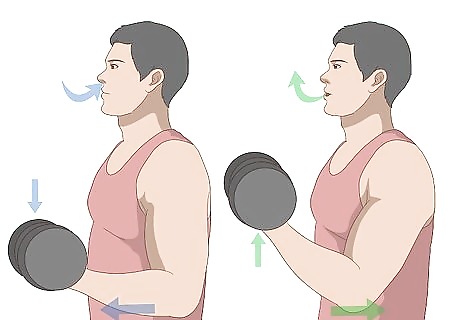
Breathing properly during strength-training exercises improves your form. The practice also helps prevent complications, like hernias. Instead of breathing erratically when you lift weights or do other strength exercises, exhale when you’re lifting and inhale when you’re lowering. For example, when you’re doing bicep curls, exhale as you lift the weight, and then inhale as you lower it back down. If you’re having trouble breathing like this, you might be lifting too much or overexerting yourself. If you do have difficulty breathing then contact your nearest doctor, or if worse an emergency ambulance.

















Comments
0 comment